#faustulus
Explore tagged Tumblr posts
Text


By Jane von Mehren
11 January 2023
The highly civilized Etruscans had a huge impact on the city’s eventual geography, architecture, government, trade, and agriculture.
They created excellent schools to which rich Romans sent their sons, much as they would later send them to Greek institutes.
By the sixth century B.C., some of Rome’s most famous institutions, from the Forum to the Senate, were in existence but even the most reputable historians — including Fabius, Livy, and Plutarch — started their accounts of the empire in legend.
Legendary beginnings

The story of Rome’s founding begins in Alba Longa, the first “city” of Latium, a region in central western Italy, occupied by Latins.
The area had been inhabited since the Bronze Age by farming communities and was known to the ancient Greeks, which is perhaps why Aeneas, a Trojan prince, is said to have established it around 1150 B.C.
According to legend, in Alba Longa, two of Aeneas’s descendants, the brothers Amulius and Numitor, fought over who would rule.
Amulius triumphed, killing Numitor’s sons and exiling his daughter, Rhea Silvia, to become a Vestal Virgin.
Through divine intervention, she gave birth to the twins Romulus and Remus.
Threatened by these potential claimants to his throne, Amulius beheaded Rhea Silvia and abandoned the babies in the river Tiber.
Miraculously, a she-wolf rescued and cared for the boys until a shepherd, Faustulus, adopted them, raising them on the Palatine Hill, located in modern-day Rome.
The legend goes on to say that the brothers established the city of Rome on the banks of the Tiber River, where it was narrow enough for crossing and the hills provided a good defensive position.
The land between the hills, however, was quite marshy and not all that fertile.
The twins soon quarreled about the city’s exact boundaries and Romulus killed Remus.
Romulus, along with the outlaws and criminals he recruited, invited neighboring tribe the Sabines, who had resisted intermarrying with the Romans, to a fête.
During the merriment, Romulus raised his cloak signaling his men to seize and abduct the young Sabine women.
As the origin story goes, being Roman wives suited the women and they stopped the Sabine men from battling the Romans when they came to recapture them.
In the end the Sabines remained in Rome as part of the new city.
Influences in the area

Archaeological evidence tells us that Rome’s actual origins were less dramatic.
The first Romans were Latin farmers and shepherds living in small village huts on the Esquiline and Palatine hills.
The Sabines, a tribe living to the north, divided soon after the city’s founding, and some of them came south and united with Rome’s people.
Rome remained relatively primitive until the 600s B.C., when the Etruscans, who controlled a series of city-states to the north, began taking control of the city.
Kingdom of Rome

While modern scholars discount some of the accounts of ancient Roman historians, they agree that during the first phase of its history — from approximately 753 to 509 B.C. — Rome was ruled by kings.
According to these writers, Romulus was the first, succeeded by Numa Pompilius, a Sabine, and in 616 B.C., by an Etruscan named L. Tarquinius Priscus.
Kings had almost absolute power, serving as administrative, judicial, military, and religious leaders. A senate acted as an advisory council.
The king chose its members, who became known as patricians, from the city’s leading families.
Unlike later monarchs, Roman kingship was not inherited.
After a king died, there was a period known as an interregnum, when the Senate chose a new ruler, who was then elected by the people of Rome.
The king-elect needed to obtain approval of the gods and the imperium, the power to command, before assuming his throne.
Etruscan influences
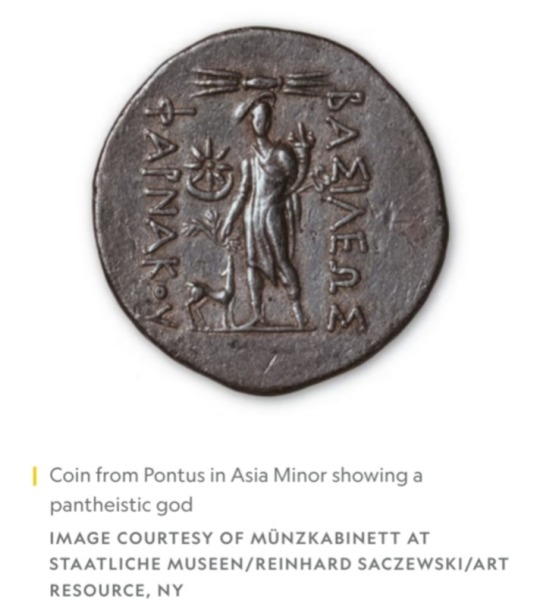
The Etruscans ruled a loose confederation of city- states that stretched from Bologna to the Bay of Naples.
It remains unclear where they originated, but they used a version of the Greek alphabet and some ancient sources describe them as coming from Asia Minor.
Around 650 B.C., they were already dominant in the region and took control of Rome, wanting its strategic position on the Tiber.
Under Etruscan kings, Rome grew from a series of villages into a proper city.
The Etruscans drained the marshes around the city, constructed underground sewers, laid out roads and bridges.
They established the cattle market, Forum Boarium, as well as Forum Romanum, the central market and meeting place that evolved into the heart of the empire.
Toward the end of this period of Etruscan influence, the first temple of Jupiter was built on the Capitoline Hill.
This temple, although rebuilt many times, became the symbol of Rome’s power.
Founding the Republic

The era of Roman kings ended in 509 B.C., when the Romans supposedly expelled the last Etruscan king, L. Tarquinius Superbus, in another mythicized event.
As recounted by historians, including Livy, the son of Tarquinius Superbus, Sextus, raped at knifepoint the noblewoman Lucretia, wife of the king’s great nephew.
Lucretia, feeling that her honor and virtue had been lost, committed suicide.
Her uncle Brutus swears to avenge her and commits to revolution and the expulsion of the monarchy.
To the Roman people, her story represents the tyrannical powers of the monarch on the state, and so the saga of Lucretia is cited as the event that spurred the Roman Republic into being.
In place of the monarchy, Romans established a republic, which lasted until 30 B.C.
Over the course of nearly five centuries, Rome became a dominant Western power, seizing territory throughout the Mediterranean, creating an enormous and efficient army, and learning how to administer its vast provinces.

NOTE:
The traditional date for the founding of Rome is 21 April 753 BC.
#Rome#Ancient Rome#Romulus#Remus#Alba Longa#Latium#Italy#Aeneas#Amulius#Numitor#Rhea Silvia#Vestal Virgin#Faustulus#Palatine Hill#Tiber River#Sabines#Etruscans#Numa Pompilius#L. Tarquinius Priscus#interregnum#imperium#Forum Boarium#Forum Romanum#Capitoline Hill#Temple of Jupiter#L. Tarquinius Superbus
14 notes
·
View notes
Text
Say it with me marauders fans: in classical myth Remus and Romulus were not raised by wolves.
They were briefly suckled by a wolf.
They were raised by a shepard called Faustulus who found them and raised them as though they were his own
Remus is not named after someone raised by wolves
#let me put my classics degree to some use pls#Remus lupin#marauders#HE’S NAMED AFTER SOMEONE WHO WAS RAISED BY SOMEONE ELSE AFTER AN ENCOUNTER WITH A WOLF#LYALL IS FAUSTULUS CONFIRMED#Sirius black
27 notes
·
View notes
Text
Understanding Roman Legend

Numitor, king of Alba Longa, was dethroned and taken prisoner by his younger brother, Amulius, who, after killing his nephews, forced his niece Rhea Silvia to enter the temple of the Vestal Virgins so that she could not have offspring. But the god Mars and Rhea Silvia fell in love. Mars fathered the twins Romulus and Remus.

Mars and Rhea Silvia (1617) by Rubens. Liechtenstein Museum
Amulius, fearing that he would have two rivals in the future, ordered the newborns to be killed. The man in charge of the infanticide did not dare to do it but he placed the babies in a basket and left them to their fate in the Tiber River. The current carried the basket to a swamp called Velabrum, between the Palatine and Capitoline hills.
In the cave known as Lupercal they were suckled by a wolf called Luperca. According to Plutarch in 'Parallel Lives: Romulus', Luperca was the sacred animal of Mars.
Shortly afterwards they were found by the shepherd Faustulus, who was working for Amulius, so he knew very well who those babies were. He decided to secretly care for the children together with his wife Acca Larentia.

The Shepherd Faustulus bringing Romulus and Remus to his wife. Nicolas Mignard (1654) Dallas Museum of Art.
When they grew up did he reveal his true identity to them and they decided to do justice. They killed Amulius and freed their grandfather from prison, who was reinstated on his throne.
Why sons of Mars and not of another god or a king?


Mars was the god of war and the army, virility, violence, revenge, and courage: all these attributes was the essence of Ancient Rome, rather the Roman army.
On the other hand, if the twins had been the sons of a man, even a king or a great warrior, they would have been ordinary men. That was a clear message to the Romans: they were not like the others; their army was not to be one among many.
Why a she-wolf?

The first food was not mother's milk or the milk of a tame animal but of a fearsome predator; A powerful message to the Romans about who they were, where they came from and where they should go. Engendered by the war, fed by ferocity; Their duty was to always be aggressive and feared by their enemies. Roman soldiers remembered at every step: “ We are sons of Mars and the Capitoline she-wolf”. And Rome, like the she-wolf called Luperca, was also capable of protecting its allies.
The foundation of Rome

The twins left their hometown of Alba Longa as they wanted to rule without overthrowing their grandfather. Romulus wanted to build a new city called Rome on the Palatine Hill, but Remus wanted to call it Remoria on the Aventine Hill. They decided that whoever saw the most vultures would win the dispute. Remus saw six and Romulus twelve.
According to tradition, Romulus founded Rome by drawing its sacred border on the afternoon of 21 April 753 BC.
Romulus had declared that no one could cross the borders of the city in arms; his brother disobeyed and crossed the limits carrying a sword, thus violating the sanctity of Rome. Romulus became enraged and a heated argument and subsequent armed confrontation began between the twins. Remus was seriously wounded and died hours later. Romulus held a funeral for his brother and buried his remains at the place where Remus had wanted to found his city Remoria.
Why a story about twins?

Romulus and Remus (1615) by Rubens. Capitoline Museums
The fact that they were twins, and not an older and a younger brother, was to make it clear that the god Mars was the father of both, and that they were 100% brothers.
So there was no doubt that Romulus and Remus represented all Romans, both in good times, when they were united and fighting for a common cause, and in times of division and conflict.
The fratricide was not premeditated. The fight was not for ambition or for a woman, it was for Rome. This story taught that, for the good of Rome, civil wars could be fought, as many as necessary.

Romulus and Remus. Silver didrachm (6.44 g). c. 269–266 BC. Photo: Curtius http://creativecommons.org/licenses/by-sa/3.0/
87 notes
·
View notes
Text




HAPPY BIRTHDAY, ROME! These coins show two foundational Roman myths.
On the first, Aeneas, alleged ancestor of Julius Caesar and founder of Rome, carries his father, Anchises, out of a burning Troy. The front shows the head of the goddess Venus, Aeneas's mother.
The second portrays the shepherd Faustulus with the twin brothers Romulus and Remus being nursed by the she-wolf. The front portrays Roma, the deity and personification of Rome.
All coins from the Elizabeth C. Evans Coin Collection at Connecticut College.
#linda lear center#connecticut college#ancient coins#history#rome's birthday#happy birthday rome#rome#ancient rome#aeneas#the aeneid#romulus and remus
33 notes
·
View notes
Note
In the Megop War God & Priest AU, Sentinel killed Orion’s sire, or at least was involved, right? Would Orion ever find out? And would he take revenge on Sentinel?
Okay so as it’s well established by now the AU is based on the Roman Myth of Romulus and Remus.
In that myth Rhea Silvia is the daughter of Numitor, the king of Alba Longa
Numitor one day gets killed or dethroned (depending on the version) by his brother Aemilius and he forces Rhea Silvia to become a vestal virgin.
Why? Because an oracle told him that the grandsons of Numitor would defeat and dethrone him. So by forcing her to join the priesthood of vesta she simply would never be able to have children and fate had been crossed.
But oh well she gets impregnated by the god of war and so Aemilius waits until the babies are born and then kills Rhea Silvia (Pro Tip: Never be a woman in ancient mythology. It never ends well) and abandons the children in the woods where they are found by a she-wolf and then their father the God Mars who asks this shepherd Faustulus to raise his sons. The kids are called Romulus and Remus, they grow up, eventually find out about their true heritage from Faustulus (after they got into a fight with some of Aemilius’ men) and then go on to defeat and dethrone Aemilius and smt smt Founding of Rome Something Something Romulus kills Remus.
TLDR; in the myth this AU is based on it’s the Children who end up taking revenge. And Sentinel in my AU essentially has Orion join the virgins of Prima for the same reasons: An oracle told him Orion’s children will defeat him.
So obviously in this AU that means Bumblebee and Cliffjumper will be the ones to avenge their grandfather. HOWEVER i have no clue yet how that would happen given in this AU bee and cliff grow up happily with their bio parents on mount olympus. So what would motivate them to go down to earth and beat up that one guy who killed the grandfather they never met and was mean to their carrier. So Sentinel WILL face justice eventually at the hands of the twins but I just do not know how or why yet.
#the war god and the priest au#transformers#maccadam#maccadams#transformers one#megop#dpax#tfa#tfa megop#tfone megop#fairytale au#roman mythology#ask#answered asks#anon ask
22 notes
·
View notes
Photo
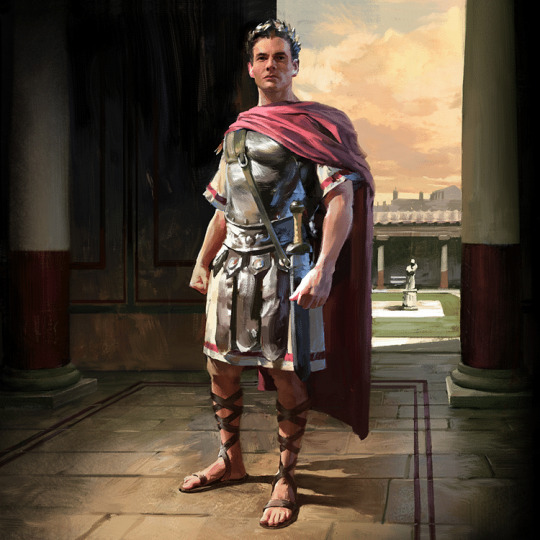
The Legend of Romulus
Despite allegedly founding Rome and being hailed a hero, Romulus’ legacy is complex and his biography is even disturbing at times. He was supposedly guilty of committing many terrible deeds that still make readers recoil, but according to legend, his transgressions often led to positive outcomes – at least from the Romans’ point of view. Thanks to his efforts' results, the Romans largely celebrated their fabled founder, and it seems that they recognized valuable lessons hiding within his biography: greatness sometimes stems from disgrace, and the path to redemption is often close at hand.
Lineage & Birth
According to Rome's canonical foundation myth, Romulus was born sometime in the 700s BCE. His parents were supposedly a priestess – called Rhea Silvia – and the god of war Mars, which provided Romulus with a pedigree second to few in the ancient world. To some, this might have intimated that he would enjoy a lifetime of opulence, without serious challenges, and he would be a paragon of morality. On the contrary, Romulus was fated for a life marked by instances of ignominy and egregious misdeeds.
Romulus’ maternal grandfather was known as Numitor, and he was king of Alba Longa, which was an influential settlement nestled in the Alban Hills of central Italy. Ancient historians traced its foundation to none other than one of Aeneas’ descendants. However, sometime after Numitor ascended to the throne, his jealous brother Amulius conspired to overthrow Numitor’s rule, and somehow, he succeeded in his endeavors and became Alba Longa’s king. In order to further secure his grasp on power, Amulius treacherously ordered the murder of Numitor’s son, Aegestus, and forced Numitor’s daughter, Rhea Silvia, to become a priestess to Vesta who was the goddess of the hearth. Since such priestesses were required to be chaste during their tenure under the pain of death, Amulius assumed that Rhea would not mother any potential rivals to the throne. But as the Romulus tale goes, Mars ravaged her one day. This led to her pregnancy, and she later gave birth to twins: Romulus and Remus.
Even though Rhea attempted to conceal the truth, Amulius learned of Rhea’s pregnancy, and shortly after Romulus and Remus’ births, the rogue, tyrannical king of Alba Longa condemned the infants to death by drowning. Yet by a dispensation of fate, they survived. Initially, a wolf named Lupa allegedly protected them until a shepherd called Faustulus rescued the boys and raised them as his own children. Around 18 years or so after their abandonment, Romulus and Remus returned to Alba Longa, led an armed revolt, and freed the Alba Longans from the despot's control, killing Amulius and placing the gentle Numitor back on the throne.
Author Promotion
Continue reading...
39 notes
·
View notes
Text

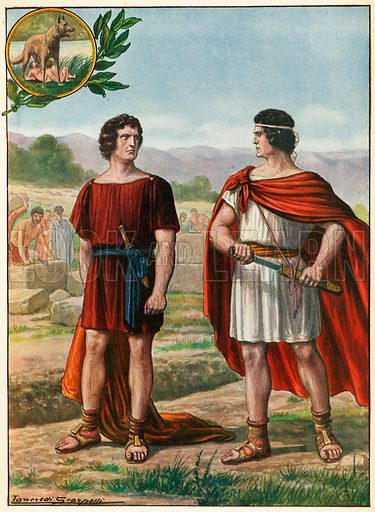
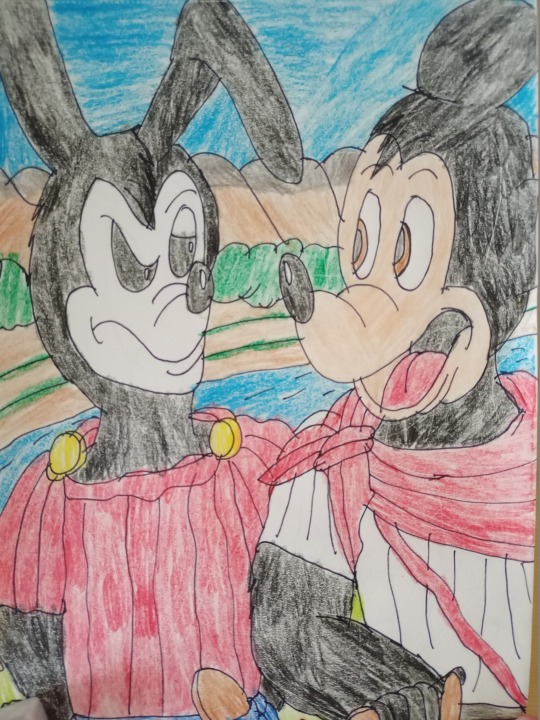
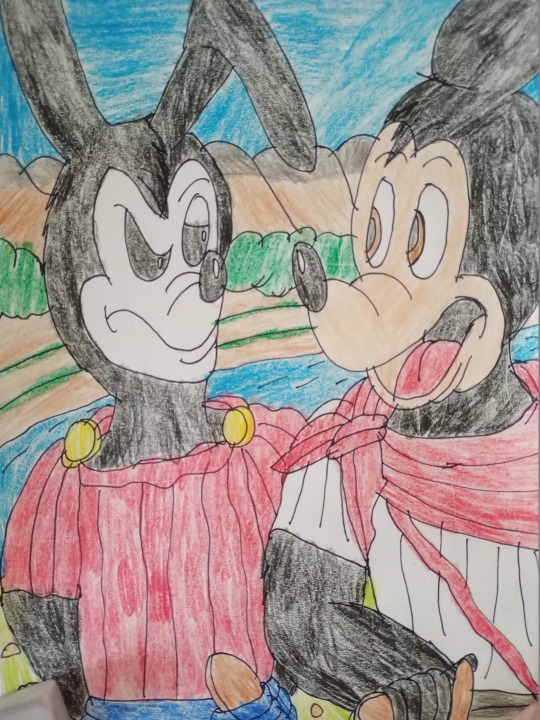
Mickey Mouse and Oswald the Lucky Rabbit as Romulus and Remus, as the founders of Rome - Toon History - History in Duckverse and Mouseverse - Happy Birthday to the Best City!
Yes, it's time to change my plans now with my new project called Toon Historia, also History in Duckverse and Mouseverse in which our famous cartoon and comic characters play famous historical figures and will play in important historical events . And first I drew Oswald the Lucky Rabbit and Mickey Mouse as the founders of Rome, as Romulus and Remus. Romulus and Remus, according to Roman mythology and Roman tradition, were the sons of Rhea Sylvia and the god Mars and grandsons of King Numitor. Numitor's brother Amulius overthrew his brother and ordered the execution of his children, including the sons of Sylvia who were thrown into the Tiber River. However, according to legend, a she-wolf found them and raised them until the shepherd Faustulus came along and adopted them. Afterwards they grew up and when they heard the truth, they went to overthrow Amulius and succeeded and restored their grandfather Numitor to be king of the city of Alba. Afterwards, Romulus and Remus went to seven hills in the valley of the Tiber River and there on April 21, 753 BC they founded the eternal city, which will be called Rome. Yes, there was a conflict between the two in which Romulus killed his brother (a tragic event) and thus took the title of the first king of Rome.
Oswald and Mickey who were created by Ub Iwerks and Walt Disney in 1927 and 1928 also became the first Disney icons, however the conflict between Iwerks and Disney resulted in Oswald being part of Universal, until in 2006 Disney bought the rights to Oswald. Yes, that's why I drew Mickey and Oswald as Romulus and Remus, because of that parallel, but don't worry, Mickey won't kill his brother, even though mice and rabbits are not the same species, they are still considered brothers because of Epic Mickey. As Romulus and Remus were the founders of Rome, so Oswald and Mickey were the founders of the new world.
I drew this last year, but I waited for this moment to publish now and I drew it as a redraw from an illustration by Tancredi Scarpelli (1866–1937) for Storia d'Italia by Paolo Giudici (Nerbini, 1929). I drew Mickey in my own style, while I left the old look for Oswald, because I still like him better with dot eyes. And yes, I drew this on the occasion of the 100th anniversary of the creation of Disney as well as the 75th anniversary of Topolino magazine, which is published in Italy, and the capital of Italy is definitely Rome. Yes, Rome, the eternal city and capital of one of the greatest empires and greatest civilizations of all time. As well as related to the birthday of the City of Rome, which is celebrated on April 21 every year. Happy Rome Day! Roma Aeterna!
I hope you like this drawing and this idea and if you want to support feel free to like and reblog this! I just ask that you don't copy my same ideas without mentioning me and without my permission. Thank you! Happy Rome Day, my favorite city in the world!
#my fanart#mickey mouse#oswald the lucky rabbit#topolino#disney#artists on tumblr#my redraw#romulus and remus#rome#history#ancient rome#mouseverse#comics#cartoons#epic mickey#mickey and oswald#toon history#duckverse in history#mouseverse in history#753 BC#21th April#disney mouse#disney rabbit#fanart#my style#my art#art#disney fanart#roma aeterna#classic disney universe
31 notes
·
View notes
Text

Denarius of the magistrate Sextus Pompeius Fostlus, minted in 137 BCE to advertise a purported family connection to Faustulus, the legendary shepherd who served as Romulus and Remus' foster-father. On the obverse, the helmeted head of the goddess Roma, with a capis (cup or bowl used for ritual purposes). On the reverse, the she-wolf suckles Romulus and Remus, while Faustulus looks on. Behind them is the fig tree known as the Ficus Ruminalis, marking the spot beside the Tiber where the twins' cradle came to rest. Photo credit: Classical Numismatic Group, Inc. http://www.cngcoins.com
#classics#tagamemnon#Ancient Rome#Roman Republic#ancient history#Roman history#classical mythology#Roman mythology#art#art history#ancient art#Roman art#Ancient Roman art#Roman Republican art#coins#ancient coins#Roman coins#Ancient Roman coins#denarius#metalwork#silver#silverwork#numismatics#ancient numismatics#Romulus#Romulus and Remus
74 notes
·
View notes
Text
//>> Lore :: Organizations
The Steely Hands was a group of thieves and pirates. They goal was it to steel from the rich and to give it to the poor. The name arose because it used to be a common punishment for theft to cut off the thief's hand. With this name they wanted to point out that their hand would never be cut off because they always escaped before anyone could catch them. It is unknown how many members the guild really has and who is part of it.
The Hood Pirates were a pirate crew founded by members of the Steely Hands who were taken in and raised by them as children. As they grew older they decided to form their own crew, to sail and explore the world.
The Royal Guards were the knights and guardians of the Pleiades family. Following the False King's takeover, many members of the guard were killed in battle, while others betrayed their oath and joined the ranks of the False King's Army.
The Aestyr Order was a collective consisting mainly of former knights, healers and scholars who had retired from active duty due to old age or other reasons. These dedicated memebers devoted their lives to protect the realm by teaching and sharing their wisdom. Their commitment to safeguarding their culture and heritage played a vital role in maintaining the strength and unity of the people. The Aestyr Order often took in orphaned children, providing them with care and education. After the attack of the False King, they collaborated with the Steely Hands, offering sanctuary to those loyal to the Pleiades family who needed to hide from the False King's men.
The Henchmen were the loyal followers of the False King, instrumental in his rise to power and the takeover of Alfheim. They are only referred by their epithets.
The Four Horsemen were the elite leaders and the vanguard of the False King's Army, serving directly under the False King.
The Two Toxicologist were two women who experts in poisons. They were directly subordinate to the False King and the False Queen, with only the four Horsemen above them.
The Three Moirai followed after the Four Horsemen and served as the king's judges and jury. All three members worked as oracle, healer and mage for the former royal family.
The Tartarus working alongside the three Moirai, he followed right after the Four Horsemen and served as guard, torturer of the prisoners and advisor and warlock of the False King and his men.
The Eight Inquisitors were directly subordinate to the Four Horsemen, the three Moirai and the False King. They led groups of soldiers in the army and were specifically tasked with hunting down anyone who opposed the False King and functioned as executors.
The Butcher Pirates were the crew who raided and killed Faustulus Galilei and took his grandson as slave. Members are: Captain Barbarossa Stede "The Butcher", First Mate Bonnet "Blackjack" Crowley, Ship's Doctor Vane "Doc" Somnus, Ship's Cook Tew Aleister "The Horrible" and Navigator Delville Alfassa "The Furie"
2 notes
·
View notes
Text
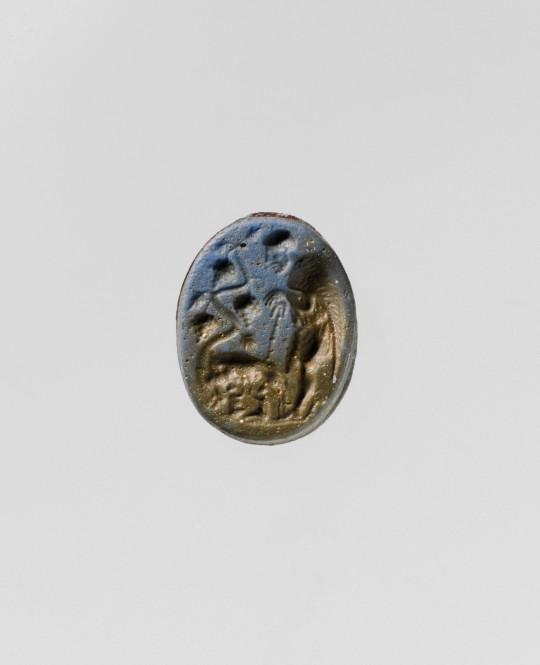
Opaque blue glass oval engraved gem. Roman 1st century BCE. x
According to tradition, Rome was founded in 753 B.C. by the twins Romulus and Remus. Sons of the god Mars and a mortal woman named Rhea Silvia, a direct descendant of Aeneas, the twins were abandoned by their uncle in the Tibur river. A she-wolf discovered them on the banks of the river and suckled them until they were taken in by a passing sheperd, Faustulus. Faustulus raised the boys together with his own twelve children until they decided to found a city of their own. They chose the spot by the Tibur where they had been rescued by the wolf, which was near the base of the Palatine hill in Rome. The representation of the wolf suckling the twins became a popular subject in Roman Republican and Imperial art. Here the sheperd Faustulus leans on his staff and watches the Roman she-wolf suckling the twins under a vine.
13 notes
·
View notes
Text

Lupa Capitolina (Capitoline Wolf) 🐺
The Capitoline Wolf (Italian: Lupa Capitolina) is a bronze sculpture depicting a scene from the legend of the founding of Rome. The sculpture shows a she-wolf suckling the mythical twin founders of Rome, Romulus and Remus. According to the legend, when King Numitor, grandfather of the twins, was overthrown by his brother Amulius in Alba Longa, the usurper ordered them to be cast into the Tiber River. They were rescued by a she-wolf that cared for them until a herdsman, Faustulus, found and raised them.
The age and origin of the Capitoline Wolf are controversial. The statue was long thought to be an Etruscan work of the fifth century BC, with the twins added in the late 15th century AD, probably by sculptor Antonio del Pollaiuolo. However, radiocarbon and thermoluminescence dating in the 21st century has suggested that the wolf portion of the statue may have been cast between 1021 and 1153, though the results are inconsistent, and there is yet no consensus for a revised dating. In a conference on this theme, most academics continued to support an ancient Etruscan origin. An analysis of the metal suggests that it contains lead from a source not known to have operated during medieval times.
The image of the she-wolf suckling Romulus and Remus has been a symbol of Rome since ancient times, and one of the most recognizable icons of ancient mythology. The sculpture has been housed since 1471 in the Palazzo dei Conservatori on the Campidoglio (the ancient Capitoline Hill), Rome, Italy, and many replicas are in various places around the world.
#lupa capitolina#capitoline wolf#romulus and remus#roman history#roman mythology#founding legend#ancient rome#classical antiquity#bronze sculpture
4 notes
·
View notes
Text
Mythic Creatures by Culture & Region
Part 3: Europe (Basque, Rome, Viking, Great Britain)
This list documents mythological and folkloric creatures of Ancient Europe, the British Isles and Scandinavia as found on Wikipedia.
European creatures from Eastern Europe, France, Germany, Italy, Greece etc. will be listed in a separate post. The same goes for Biblical creatures or creatures from Abrahamic religions and Goetia literature. The full list of creatures is here.
Basque
Basque people live in what is today northern Spain. Their language is the only surviving language in Europe that isn't part of the Indo-European family tree, likely because the Basques live in secluded mountain areas. I have listed some deities alongside creatures, but this is a full list of Wikipedia's Basque creatures, not a full list of Wikipedia's gods/goddesses/deities for Basque culture.
Aatxe; Aide air goddess; Akerbeltz; Amalur; Basajaun; Eate (Basque god); Egoi; Eki (Basque goddess); Fountain Women; Gaizkiñ; Gaueko; Herensuge; Ilargi; Inguma; Iratxo ; Iratxoak; Jentil; Lamignak; Mairu; Minairó also Catalan; Odei; Olentzero; Orko; San Martin Txiki; Tartalo
Proto-Indo-European
Proto-Indo-European (or PIE) is the reconstructed ancestor to all major European languages, excluding Basque and languages from later diasporas.
Dʰéǵʰōm; Proto-Indo-European Myth; Double-headed eagle maybe not PIE but Bronze Age
Roman
Abarimon (Pliny the Elder, whose source is supposedly a land surveyor of Alexander the Great); Aborigines_Roman myth\; Achlis (Pliny the Elder); Caligo, see Achlys; Aegipan (Pliny the Elder locates them in Libya); Albruna Germanic seeress attested by Tacitus; Amazons, Amazons (List); Anguiped also Greek and Iranian.; Antichthones; Astomi Pliny the Elder; Aura; Bonnacon Pliny the Elder; Caca; Caeneus; Caladrius; Calingae Pliny the Elder; Camilla; Catoblepas Pliny the Elder; Cimbrian seeresses mentioned by Strabo; Crocotta Strabo and Pliny the Elder; Cupid; Di Penates; Echeneis Pliny the Elder; Ethiopian pegasus Pliny the Elder; Faun, Faunus ; Faunae, Fauni; Faustulus; Forest Bull Pliny the Elder; Fraus; Genius; Genius loci; Gorgades; Hellusians Tacitus claims they live beyond the Finns; Hircocervus; Hooded Spirits; Hydrus Pliny the Elder; Ichneumon Pliny the Elder; Ichthyophagoi; Indus worm; Iphis; Kings of Alba Longa; Lampedo Amazon; Lares; Lares Familiares; Lemures; Mandi; Manes; Manticore; Monoceros Pliny the Elder; Monopod; Odontotyrannus; Orcus; Pandi; Phoenix; Phthisis; Pyrausta Pliny the Elder; Querquetulanae; Remora; Salamander; Seps; Silvanus; Strix; Syrbotae Pliny the Elder; Tarand; Theow Pliny the Elder; Unicorn; Wild Man, Wild Woman ; Wild Men, Wild Women; Yale
Etruscan
Charun; Orcus; Tuchulcha; Vanth; Vegoia
Britain
Apple Tree Man; Ascapart giant from chivalric romance dating to 1300s; Asrai Cheshire and Shropshire; Barghest north England; Beast of Dean; Beithir; Billy Blind England and Scottish Lowlands; Black Annis; Black Dog; Black Shuck; Bluecap; Blunderbore; Bogeyman; Boggart; Bogle Northumbrian; Brag Northumbrian; British Wild Cats; Brown Man of the Muirs anglo-scottish border; Brownie ; Brownies; Bucca Cornish; Bugbear; Burryman; Butter Sprite; Calygreyhound; Cat-sìth; Cauld Lad of Hylton; Inspiration/Directories/Bestiary (Myth and Legend)/A-Z/Changeling|Changeling; Christchurch Dragon; Cirein-cròin; Cock Lane Ghost; Cockatrice (explicitly British); Cofgod; Colbrand (giant); Colt pixie; Cormoran (giant); Dando's Dogs; Drummer of Tedworth; Dun Cow; Dunnie Northumbrian; Elder Mother; English Fairies; Ettin; Fairy story (Northumbria); Fetch; Finfolk Orkney; Girt Dog of Ennerdale; Goram and Vincent (giants); Grendel; Grendel's Mother; Grimalkin; Grindylow; Gytrash; Habetrot (Northumbrian?? border counties between England and Scottish Lowlands); Hob; Hobbididance; Hobgoblin ; Hobgoblins; Imp; Jack and the Beanstalk; Jack Frost; Jack in the Green; Jack o' Legs; Jack o' the bowl; Jack the Giant Killer; Jack-In-Irons; Joan-in-the-Wad; Kilmoulis Anglo-Scottish border; Knocker; Knucker; Korred; Krabat; Lambton Worm; Lantern Man; Lazy Laurence; Lubberfiend; Martlet; Mary Lakeland (accused witch); Mermaid of Zennor; Morgan le Fay; Morgawr; Nanny Rutt; Nelly Longarms; Nuckelavee Orkney; Nuggle Shetland; Pantheon_the_creature; Peg Powler; Penhill Giant; Pictish Beast Picts; Pillywiggin; Pixie; Portunes; Púca; Puck; Puck_Shakespeare; Queen of Elphame (Northumbrian?? border counties between England and Scottish Lowlands); Redcap English-Scottish border; Screaming skull; Sea Mither Orkney; Sebile; Sheela na Gig; Shug Monkey; Simonside Dwarfs; Sockburn Worm; Spriggan ; Spriggans; Sprite ; Sprites; Stoor worm; Sweet William's Ghost; Tangie Orkney and Shetland; The Black Dog of Newgate; The Elder Mother also Scandinavian; The Hedley Kow Northumberland; The King of the Cats; The Laidly Worm of Spindleston Heugh Northumbrian; The Queen of Elfan's Nourice; Thunderdell Cornish; Tiddalik; Tom Hickathrift; Tooth Fairy; Tree Elves; Trow; Unicorn; Wight; Wild Man, Wild Woman ; Wild Men, Wild Women; William of Lindholme; Worm of Linton; Wyvern; Yallery Brown
Isle of Man
Adene, elves?; Arkan sonney "lucky piggy"; Ben-Varrey see "Mermaid"; Buggane; Cailleach; Fenodyree; Glashan; Glashtyn; Jimmy Squarefoot; Moddey Dhoo; Mooinjer Veggey; Sleigh Beggey; Tree Elves; Water Bull
Irish
Abarta either Tuatha or Fomorian (depends on account); Abcán the poet and musician of the Tuatha, a dwarf (in stature?); Abhartach; Aes Sidhe; Aibell, an elf queen (banshee, ruler of a fairy mound); Aillen, the "burner" a monstrous Tuatha; Aos Sí; Badb; Balor; Bánánach; Banshee; Baobhan Sith; Biróg a lheannan sidhe; Bodach also Scottish; Bran and Sceólang; Brendan the Navigator; Cailleach; Carman; Cas Corach; Cat-sìth also Scottish; Cathbad; Cethlenn; Cichol Gricenchos; Clíodhna; Clurican; Conand; Crom Cruach; Cù-sìth; Dobhar-chú; Donn Cúailnge; Dullahan; Each-uisge; Echtra; Elatha; Ellén Trechend; Enbarr; Ethniu; Failinis; Fear Doirich; Fear gorta; Finvarra; Fionn mac Cumhaill; Fionnuala; Fir Bolg; Fir Darrig; Fomorian; Gancanagh; Garb mac Stairn; Glas Gaibhnenn; Immram; Irish Mythic Creatures; Iubdan; Joint-eater; Kelpie; Leprechaun; Les Lavandières; Lhiannan-Sidhe; Liban; Inspiration/Directories/Bestiary (Myth and Legend)/A-Z/Manannán mac Lir|Manannán mac Lir; Medb (Queen Maeve); Merrow ; Merrows; Mongfind; Muckie; Mug Ruith; Nel; Niamh; Oilliphéist; Onchú; Pillywiggin; Púca; Sadhbh; Salmon of Knowledge; Scáthach; Selkie; Sengann; Seonaidh; Sheela na Gig; Sidhe; Sìth also Scottish; Sluagh also Scottish; Sovereignty goddess; Sreng; Swan Maiden; Tethra; The Morrígan; The Voyage of Bran; The Voyage of Máel Dúin; The Voyage of the Uí Chorra; Tlachtga; Tuatha dé Danaan; Werewolf; Werewolves of Ossory; Wild Man, Wild Woman ; Wild Men, Wild Women; Wyvern allegedly Irish; Cymidei Cymeinfoll
Scotland
Am Fear Liath Mòr; Red Cap; Bauchan; Bean-nighe; Beast of Beinn a' Bheithir; Betram de Shotts; Biasd Bheulach; Billy Blind lowlands and England; Blue Men of the Minch; Bodach also Irish; Boobrie west coast Scottish lochs; Broichan wizard of Pictland (north Scotland); Brown Man of the Muirs anglo-scottish border; Brownie ; Brownies; Cailleach; Cain bairns; Ceasg; Cù-sìth; Each-uisge; Fachan; Fuath; Ghillie Dhu; Gigelorum; Glaistig; Gormshuil Mhòr na Maighe; Kelpie also Irish; Lavellan; Les Lavandières; Ly Erg; Maggy Moulach; Morag; Muc-sheilch; Nicnevin; Pech; Red Cap; Seelie; Shellycoat; Sìth also Irish; Sithchean Hebrides; Sluagh; Spey-wife; Tam Lin; The Green Man of Knowledge; Water Bull; Water Horse; Wild Haggis; Wirry-cow; Wulver
Welsh
Adar Llwch Gwin; Adar Rhiannon birds from Mabinogi and Welsh Arthurian tales; Aderyn y corff, corpse bird, portent of death; Afanc; Arawn; Bendith y Mamau see Tylwyth Teg; Blodeuwedd; Brenin Llwyd; Bres Tuatha; Buwch Frech; Bwciod; Cath Palug; Ceffyl Dŵr; Coblynau; Cŵn Annwn; Cyhyraeth; Cymidei Cymeinfoll; Cythraul; Dormarch; Gwagged Annwn or Gwragedd Annwn; Gwrgi Garwlwyd; Gwyllgi; Gwyllion; Gwyn ap Nudd; Henwen; Idris Gawr; Jack o' Kent; Les Lavandières; Llamhigyn Y Dwr; Maelor Gawr; March Malaen; Mari Lwyd; Morgen; Sleigh Beggey also Manx; Swan Maiden; Twrch Trwyth; Tylwyth Teg; Welsh Dragon; Welsh Giant; White dragon; Wild Hunt; Wyvern; Y Ladi Wen; Ysbaddaden; Ysgithyrwyn
Scandinavian (Viking, Sweden, Norway, Denmark, Iceland)
Æsir; Æsir–Vanir War; Alberich in Thidrekssaga written in 1250 in Norway, possibly based on a Plattdeutsch original (also appears in German Nibelungenlied from 1200 in Passau, Bavaria and Ortnit from 1230s Germany, Strassburg; Álfablót sacrifice to elves; Alvaldi jotun; Askafroa German "Eschenfrau"; Bergsrå; Berserker; Bøyg; Brokkr dwarf; Brunnmigi; Bysen; Church grim; Dagr; Death; Deildegast; Di sma undar jordi; Disir; Dökkálfar; Draugr; Dvalinn; Dwarf ; Dwarfs, Dwarves; Eikþyrnir; Einherjar; Elder Mother; Elli; Endill jotun; Fenrir; Fin; Fjölvar; Fjörgyn and Fjörgynn; Fossegrim; Fylgiar; Gangr; Garmr; Gjenganger; Glenr; Gríðr; Grýla and Leppalúði; Gulon; Hábrók; Hafgufa; Half-elf; Hamingja; Hati Hróðvitnisson; Helhest; Hervör alvitr; Hildr; Hlaðguðr svanhvít; Hljod; Hlökk; Hræsvelgr; Hrímgerðr; Hrímgrímnir; Hroðr; Hrymr; Hulder; Huldufólk; Humli; Hyrrokkin; Iði; Ím (joetunn); Járnsaxa; Jörmungandr; Jötunn; Katie Woodencloak; Kraken; Lagarfljótsormur; Landdisir; Landvættir; Leikn; Ljósálfar; Lyngbakr; Marmennill; Móðguðr; Mögþrasir; Mound Folk; Myling; Nafnaþulur; Níðhöggr; Niß Puck; Nisse; Norns; Norse_Nude_Snake_Witch; Nótt; Nykken; Odin; Púca; Rå; Rådande; Ratatoskr; Sæhrímnir; Selkolla; Selma; Sjörå; Skogsrå; Sköll; Skrat; Skuld (half-elf princess); Skvader; Slattenpatte; Sleipnir; Storsjöodjuret; Sumarr and Vetr; Surtr; Svaðilfari; Svartálfar; Swan Maiden; The Elder Mother also English; The Giant Who Had No Heart in His Body; Tilberi; Tooth Fairy; Tree Elves; Troll; Troll Cat; Vættir; Valkyrie; Valravn; Vanir; Vardøger; Veðrfölnir; Viðfinnr; Vittra; Vǫrðr; Vörnir (joetunn); Vosud; Werewolf; Wight; Wild Hunt; Wild Man, Wild Woman ; Wild Men, Wild Women; Worm of Linton; Wurm; Ysätters-Kajsa; Yule cat; Þorbjörg lítilvölva; Þorgerðr Hölgabrúðr and Irpa; Þrívaldi; Þuríðr Sundafyllir
Note: Although most European lore is easily implemented into art and fiction without causing lasting cultural damage, there may be some European cultures (from Basque to Welsh) whose cultures have been subject to cultural suppression. Notify me if there are mistakes or if I need to add disclaimers or revisions concerning these creatures.
#mythic creature list#mythical creatures#mythological creatures#mythology#folklore#legendary beings#legendary creature list#monster list#list of monsters
4 notes
·
View notes
Text

When the Greeks sacked Troy, Aeneas retreated to Mount Ida, carrying his father Anchises on his shoulders and carrying his son Ascanius. His wife Creusa died in flight. He reigned for a time in Ida, then undertook a long voyage across the Mediterranean.
This Trojan hero went through several adventures in which different deities participated including his mother, Venus (Afrodita) . After his father's death in Sicily, a storm blew him astray and washed him onto the shores of Carthage.

Aeneas tells Dido the misfortunes of the Trojan city. Oil on canvas by Pierre-Narcisse Guérin (1815) Louvre, Paris.
With the intervention of the goddess Venus, queen Dido of Carthage fell in love with Aeneas and wanted them to marry, uniting their lineages. But Jupiter opposed it and sent Mercury to warn him that he must continue his journey and fulfill his destiny.
Dido, outraged at being abandoned , cast a curse declaring that her people and the people descended from Aeneas would be enemies. After this, she stabbing herself with a sword on a pyre.

Death of Dido. Oil on canvas by Guercino (1631)
Back in Sicily, Aeneas celebrated great funeral games in memory of his father, who appeared to him to tell him that he must go to Cumae and descend into the underworld. In Cumae, Aeneas succeeded in having the Sibyl open the gates of Hades for him.
There he met the shadow of Dido, but he also saw his father, who in the Elysian Fields revealed to him the glorious destiny of the people he was to found in Italy.

Aeneas and the Cumaean Sibyl. Oil on canvas by François Perrier (1646)
He reached the mouth of the Tiber and finally entered a city called Pallantium on the Palatine Hill. There, after going through several epic situations, he married Lavinia, only daughter of Latinus, king of the Latins, and founded the city of Lavinium, named after his wife.
Aeneas disappeared in the middle of a storm and was taken to Olympus and crowned by his mother Venus. His eldest son Lullius, from whom the Julii descend, founded Alba Longa the hometown of Romulus and Remus.
According to Livy, Lullius is the son of Aeneas and Lavinia, and seems to distinguish him from Ascanius son of Aeneas and Creusa. Silvius, son of Lullius, succeeded him on the throne of Alba Longa. Dionysius of Halicarnassus is the one who says that Silvius was the son of Aeneas and Lavinia, and therefore half-brother of Lulilus (Ascanius)
Years later, Numitor, maternal grandfather of Romulus and Remus and direct descendant of Silvius would be king of Alba Longa

Roman bas-relief, 2nd century: Aeneas lands in Latium leading his son Lullius (Ascanius); the sow identifies the place to found his city : Alba Longa
Over time, coming into contact with civilizations in the Eastern Mediterranean, the Romans realized that while everyone else had legends of heroes, epic wars, and several divinities interacting with humans at each event, they only had Mars in their founding story; twins thrown into a river, suckled by a wolf in a cave, adopted by a humble shepherd. And one of the twins ends up dying in a fight with the other.

Romulus and Remus, suckled by the wolf, found by Faustulus on banks of Tiber. Fresco by Giuseppe Cesari (1568-1640)
Augustus commissioned the great Roman poet Virgil to create a epic worthy of Rome, but without annulling its legendary founding history.
Through the Aeneid, Rome acquired a prestigious past; a mystical explanation of the three Punic Wars and the destruction of Carthage. Julia gens obtained a divine origin, giving even more legitimacy to the ruling dynasty. Furthermore, this epic exalts the Roman virtues that Augustus so wanted to restore and impose by law.
According to Roman historians, Augustus' sister Octavia faint from emotion upon hearing Virgil reading the Aeneid.

Virgil Reading the Aeneid to Augustus and Octavia. Neoclassical painting by Jean-Joseph Taillasson, 1787
In the story of the Trojan War as told by Homer, Aeneas appears as a secondary character, after heroes such as the Greek Achilles or the Trojan Hector. Meanwhile Virgil made him a protagonist in an epic that linked the fall of Troy and the founding of Rome.

The Siege of Troy. Oil on canvas by French School ( 17th century)
#ancient rome#history#mythological painting#oil painting#oil on canvas#fresco#the aeneid#roman empire#greco roman#painting
43 notes
·
View notes
Text
Romulus und Remus
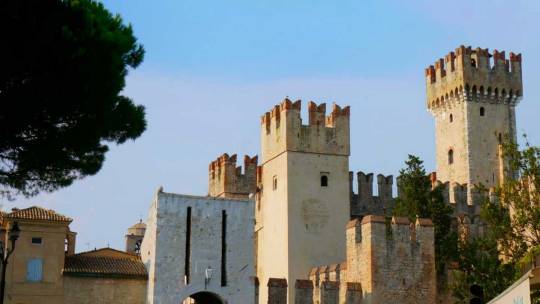
Romulus und Remus · Römische Sage · Schicksal
Einer der königlichen Nachkommen aus des Äneas Stamm war der Albanerkönig Prokas, der bei seinem Tod zwei Söhne, Numitor und Amulius, hinterließ. Selten sah man so große Unterschiede zwischen zwei Brüdern; Numitor, der ältere, hatte ein sanftes und gutmütiges Wesen, während Amulius aufbrausend und herrschsüchtig war. Ehrgeiz und diese Herrschsucht trieben Amulius dazu, den Bruder vom Thron zu stoßen und aus dem Land zu verbannen. Aus Furcht vor der Vergeltung ließ er des Bruders Sohn auf der Jagd meuchlings töten. Die Tochter Numitors, Rhea Silvia, machte er zur Priesterin der Vesta, in deren Dienst sie unvermählt bleiben musste. So schien jede Bedrohung seines Thrones beseitigt. Da begab es sich, dass der Kriegsgott Mars die schöne vestalische Jungfrau erblickte und sich heimlich mit ihr vermählte. Als Rhea Silvia ein Zwillingspaar gebar, kannte der Zorn ihres Oheims Amulius keine Grenzen; denn er fürchtete, dass die Kinder, Enkel des rechtmäßigen Königs Numitor, sich einst an ihm rächen könnten. Nach dem strengen Gesetz der Göttin Vesta musste Rhea Silvia wegen ihres Vergehens mit dem Tode bestraft werden. Die Zwillinge aber sollte ein Diener nach des Königs Gebot in den Tiber werfen. Nun war der Fluss gerade in jenen Tagen über seine Ufer getreten, und so überließen des Königs Beauftragte die Kinder ihrem Schicksal in einem Körbchen, das sie in das strömende Wasser setzten. Der Korb schaukelte auf den Wellen dahin und gelangte in eine Landschaft, die von sieben Hügeln gekrönt war. Dort blieb er im Geäst eines Feigenbaumes hängen, und als das Wasser gefallen war, stand er mit seiner wimmernden Fracht auf dem Trockenen. Der Kriegsgott Mars war besorgt um das Schicksal seiner Söhne und sandte ihnen die ihm geheiligten Tiere. Von der Höhe des Berges Palatinus kam eine Wölfin, die ihren Durst im Fluss löschen wollte, und bemerkte die hilflosen Kinder; sie schleppte sie in ihre Höhle, bettete sie weich und säugte sie. Später brachte der Specht, der heilige Vogel des Mars, Körner und wohlschmeckenden Samen. So wurden die Zwillinge mit kräftiger Nahrung am Leben gehalten. Eines Tages kam Faustulus, ein einfacher Ziegenhirt, auf der Suche nach einem seiner Tiere des Weges und gewahrte das wundersame Schauspiel in der Höhle. Er empfand Mitleid mit den Knaben und brachte sie zu seiner Frau, die eben ihr Söhnchen durch den Tod verloren hatte. Aus Mitleid nahm Acca Larentia, die Hirtenfrau, sich der Zwillinge an. Die Pflegeeltern gaben ihnen die Namen Romulus und Remus. Als die Kunde von dem Schicksal Rhea Silvias und ihrer Kinder auch in diese Einsamkeit gelangte, wurde es Faustulus offenbar, wie es mit der Herkunft der beiden Knaben bestellt sei. Er erkannte, dass er Numitors Enkel gerettet hatte; doch aus Furcht vor der Rache des Königs Amulius behielt er sein Geheimnis bei sich. In der ländlichen Freiheit wuchsen die Zwillinge zu kräftigen Jünglingen heran, durchstreiften mit ihren Altersgenossen Wald und Flur und bauten sich auf dem Palatinischen Berg ihre Hütten. Häufig mussten sie, jeder an der Spitze einer Schar von Getreuen, ihre Kraft mit wilden Tieren messen, welche die Herden bedrängten. Oft lagen sie auch im Streit mit anderen Hirten, besonders mit denen des vertriebenen Königs Numitor, der auf einem kleinen Gehöft ein zurückgezogenes, stilles Leben führte. Einst geschah es bei solchen Streitigkeiten, dass Remus sich der Übermacht der feindlichen Hirten nicht erwehren konnte und von ihnen gefangen weggeschleppt wurde. Sie brachten ihn vor ihren Herrn, den greisen Numitor. Tief betroffen blickte dieser auf den Jüngling, die Ähnlichkeit mit seinem Sohn schien ihm unverkennbar. Bald darauf stellten sich auch, getrieben von der Sorge um Remus, der treue Faustulus und Romulus ein, um den Gefangenen freizubitten. Faustulus offenbarte dem Alten nun die ganze Wahrheit, und überglücklich umarmte Numitor, der rechtmäßige König, seine beiden jungen Enkel. Vor allem Volk, das herbeigeströmt war, schworen Romulus und Remus den Eid, die ihnen zustehende Herrschaft zu gewinnen. Die beiden Jünglinge riefen ihre Gefährten und die anderen Männer zum Vergeltungsfeldzug auf, zogen nach Alba Longa und drangen mit List in die Königsburg ein. Im Kampf um die Burg fand Amulius den Tod, und unter dem Jubel des Volkes setzten Romulus und Remus ihren greisen Großvater wieder in seine königlichen Rechte ein. Numitor liebte seine Enkel zärtlich, und er war glücklich bei dem Gedanken, dass sie nach seinem Tod als Doppelkönige die Geschicke Alba Longas lenken würden. Doch die Götter fügten es anders. Romulus und Remus · Römische Sage Read the full article
0 notes
Text

@protectcosette
"where you got the idea" : in every English dictionary that exists with a "she-wolf" entry on it...
Depending on your personal culture and cultural/social bubble, people will be used to hearing it both ways. In my own, it is mostly used for the actual animal, but a mentioned in the post, I deal with specificities and connotations, and "she-wolf" as "sexual woman" is very much too anchored in the meaning for me to want to translate it as such.
also Romulus and Remus' wolf-mother being called a she-wolf is a double entendre both in English and the original Latin, because in Latin, "lupa" means both wolf [female] and prostitute. The double meaning of "wolf [female]" and "woman associated with sex" exists within the Latin text, and is transposed well into the English translation. In the most well-known version, that she-wolf is indeed a wolf. In another, not even a particularly like obscure one, that "she-wolf" is a prostitute — Acca Larentia, mistress of Faustulus. I appreciate the message I do but the "she-wolf = woman associated with sex" is very much present in the foundational myth of Rome 😭 in it more than in anywhere tbh. as much as in the Shakira song. and in any dictionary with an entry for "she-wolf" in it...
"will IA ever replace human translators?" bet dude. I wrote some lines in french (my mother tongue) in which I used "louve" [female wolf] and translating it for a friend I did not know what word to use to get her across for "wolf" does not convey the motherness/warmth of the scene, "she-wolf" has a sexual connotation unfit for it, and "wolf-mother" is also unfit as it uses the word "mother" and as such is thematically dissonant because both characters are motherless. A machine cannot have such considerations. Human translators deal with loss.
#just because i say english is not my mother tongue doesnt mean i dont know what im talking about or need soothing of mind over things i know#are true... theres a reason i spend such time on potential translations.... because i know both languages and can comfortably#and while understanding the subtleties of both#navigate between the two...
241 notes
·
View notes
Text
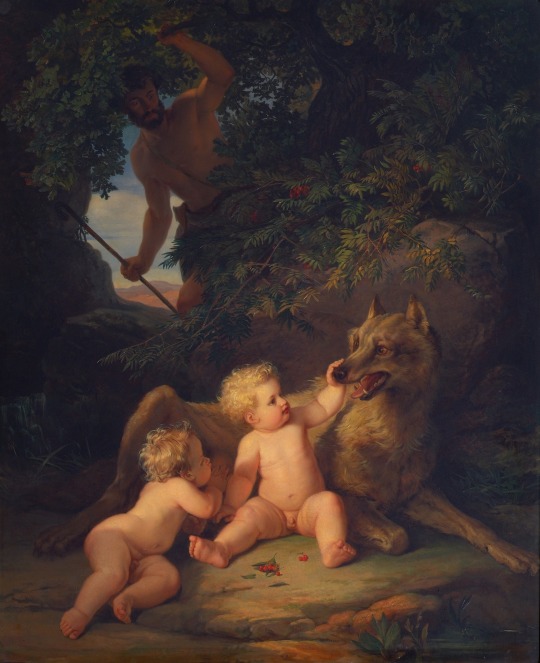
Romulus and Remus by Joseph Binder
#romulus#remus#art#roman mythology#ancient rome#ancient romans#rome#roman#romans#founding#wolf#lupa#faustulus#sheperd#history#mythology#mythological#europe#european#antiquity#kingdom#twins#twin brothers#brothers#joseph binder#lupercal#she wolf#river tiber#lupa capitolina#capitoline
766 notes
·
View notes